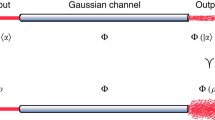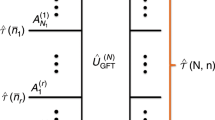Abstract
In the present paper, we give a proof of optimality of Gaussian encodings for the ultimate communication rate of generalized noisy homodyne and heterodyne receivers under the oscillator energy constraint, without any additional “threshold condition” onto the signal power. Rather remarkably, the proof is based on various generalizations of the celebrated log-Sobolev inequality motivated by a solution of the problem of Gaussian maximizers for the capacity of quantum measurement channels.


Similar content being viewed by others
Data availability
Data sharing is not applicable to this article as no datasets were generated or analyzed during the current study.
Notes
We denote by Sp the trace of \(2s\times 2s\)-matrices as distinct from the trace of operators on \({\mathcal {H}}\).
We denote by \(I_{s}\) the unit \(s\times s-\)matrix.
The Wehrl inequality proved by Lieb [23] corresponds to \(\beta _{q}=\beta _{p}=1/2\) and gives the minimal entropy \(\ln 2\pi e\) attained on the coherent states.
References
Carlen, E.A.: Some integral identities and inequalities for entire functions and their application to the coherent state transform. J. Funct. Anal. 97(1), 231–249 (1991). https://doi.org/10.1016/0022-1236(91)90022-W
Caves, C.M., Drummond, P.D.: Quantum limits on bosonic communication rates. Rev. Mod. Phys. 66(2), 481–537 (1994). https://doi.org/10.1103/RevModPhys.66.481
De Palma, G.: Uncertainty relations with quantum memory for the Wehrl entropy. Lett. Math. Phys. 108(9), 2139–2152 (2018). https://doi.org/10.1007/s11005-018-1067-y
Giovannetti, V., Holevo, A.S., Garcia-Patron, R.: A solution of Gaussian optimizer conjecture for quantum channels. Commun. Math. Phys. 334(3), 1553–1571 (2015). https://doi.org/10.1007/s00220-014-2150-6
Giovannetti, V., Holevo, A.S., Mari, A.: Majorization and additivity for multimode bosonic Gaussian channels. Theor. Math. Phys. 182(2), 284–293 (2015). https://doi.org/10.1007/s11232-015-0262-6
Gross, L.: Logarithmic Sobolev inequalities. Am. J. Math. 97(4), 1061–1083 (1975). https://doi.org/10.2307/2373688
Hall, M.J.W.: Gaussian noise and quantum-optical communication. Phys. Rev. A 50, 3295–3303 (1994). https://doi.org/10.1103/PhysRevA.50.3295
Hall, M.J.W.: Information exclusion principle for complementary observables. Phys. Rev. Lett. 74, 3307–3311 (1995). https://doi.org/10.1103/PhysRevLett.74.3307
Holevo, A.: On the classical capacity of general quantum Gaussian measurement. Entropy 23(3), 377 (2021). https://doi.org/10.3390/e23030377
Holevo, A.S.: Probabilistic and Statistical Aspects of Quantum Theory, 2nd edition. Edizioni Della Normale, Pisa, (2011). https://doi.org/10.1007/978-88-7642-378-9
Holevo, A.S.: Information capacity of a quantum observable. Probl. Inform. Transm. 48(1), 1–10 (2012). https://doi.org/10.1134/S0032946012010012
Holevo, A.S.: On the constrained classical capacity of infinite-dimensional covariant quantum channels. J. Math. Phys. 57(1), 015203 (2016). https://doi.org/10.1063/1.4928050
Holevo, A.S.: Quantum Systems, Channels, Information: A Mathematical Introduction, 2nd edition. De Gruyter, Berlin/Boston, (2019). https://doi.org/10.1515/9783110642490
Holevo, A.S.: Gaussian maximizers for quantum Gaussian observables and ensembles. IEEE Trans. Inform. Theory 66(9), 5634–5641 (2020). https://doi.org/10.1109/TIT.2020.2987789
Holevo, A.S.: Accessible information of a general quantum Gaussian ensemble. J. Math. Phys. 62(9), 092201 (2021). https://doi.org/10.1063/5.0048112
Holevo, A.S.: Structure of a general quantum Gaussian observable. Proc. Steklov Inst. Math. 313, 70–77 (2021). https://doi.org/10.1134/S0081543821020085
Holevo, A.S.: Log-Sobolev inequality and proof of Hypothesis of the Gaussian Maximizers for the capacity of quantum noisy homodyning, (2022). Preprint at https://arxiv.org/abs/2204.10626
Holevo, A.S., and Filippov, S.N.: Proof of the Gaussian maximizers conjecture for the communication capacity of noisy heterodyne measurements, (2022). Preprint at https://arxiv.org/abs/2206.02133
Holevo, A.S., Kuznetsova, A.A.: Information capacity of continuous variable measurement channel. J. Phys. A: Math. Theor. 53(17), 175304 (2020). https://doi.org/10.1088/1751-8121/ab7df8
Holevo, A.S., Yashin, V.I.: Maximum information gain of approximate quantum position measurement. Quant. Inf. Process. 20, 97 (2021). https://doi.org/10.1007/s11128-021-03046-8
Horodecki, M., Shor, P.W., Ruskai, M.B.: Entanglement breaking channels. Rev. Math. Phys. 15(6), 629–641 (2003). https://doi.org/10.1142/S0129055X03001709
Lee, J., Ji, S.-W., Park, J., Nha, H.: Gaussian benchmark for optical communication aiming towards ultimate capacity. Phys. Rev. A 93, 050302 (2016). https://doi.org/10.1103/PhysRevA.93.050302
Lieb, E.H.: Proof of an entropy conjecture of Wehrl. Commun. Math. Phys. 62, 35–41 (1978). https://doi.org/10.1007/BF01940328
Lieb, E.H., and Loss, M.: Analysis. Am. Math. Soc., (2001). Section 8.14
Luo, S.: A simple proof of Wehrl’s conjecture on entropy. J. Phys. A: Math. Gen. 33(16), 3093 (2000). https://doi.org/10.1088/0305-4470/33/16/303
Mari, A., Giovannetti, V., Holevo, A.S.: Quantum state majorization at the output of bosonic Gaussian channels. Nat. Commun. 5(1), 1–5 (2014). https://doi.org/10.1038/ncomms4826
Schäfer, J., Karpov, E., García-Patrón, R., Pilyavets, O.V., Cerf, N.J.: Equivalence relations for the classical capacity of single-mode Gaussian quantum channels. Phys. Rev. Lett. 111, 030503 (2013). https://doi.org/10.1103/PhysRevLett.111.030503
Serafini, A.: Quantum Continuous Variables: A Primer of Theoretical Methods. CRC Press, Taylor & Francis Group, Boca Raton, (2017). https://doi.org/10.1201/9781315118727
Shirokov, M.E.: The Holevo capacity of infinite dimensional channels and the additivity problem. Commun. Math. Phys. 262(1), 137–159 (2006). https://doi.org/10.1007/s00220-005-1457-8
Shirokov, M.E.: On properties of quantum channels related to their classical capacity. Theory Probab. Appl. 52(2), 250–276 (2008). https://doi.org/10.1137/S0040585X97982980
Shor, P.W.: Additivity of the classical capacity of entanglement-breaking quantum channels. J. Math. Phys. 43(9), 4334–4340 (2002). https://doi.org/10.1063/1.1498000
Takeoka, M., Guha, S.: Capacity of optical communication in loss and noise with general quantum Gaussian receivers. Phys. Rev. A 89, 042309 (2014). https://doi.org/10.1103/PhysRevA.89.042309
Acknowledgements
The work was supported by the grant of Russian Science Foundation 19-11-00086, https://rscf.ru/project/19-11-00086/.
Author information
Authors and Affiliations
Corresponding author
Ethics declarations
Conflict of interest
On behalf of all authors, the corresponding author states that there is no conflict of interest.
Additional information
Publisher's Note
Springer Nature remains neutral with regard to jurisdictional claims in published maps and institutional affiliations.
Rights and permissions
Springer Nature or its licensor (e.g. a society or other partner) holds exclusive rights to this article under a publishing agreement with the author(s) or other rightsholder(s); author self-archiving of the accepted manuscript version of this article is solely governed by the terms of such publishing agreement and applicable law.
About this article
Cite this article
Holevo, A.S., Filippov, S.N. Quantum Gaussian maximizers and log-Sobolev inequalities. Lett Math Phys 113, 10 (2023). https://doi.org/10.1007/s11005-023-01634-6
Received:
Revised:
Accepted:
Published:
DOI: https://doi.org/10.1007/s11005-023-01634-6
Keywords
- Quantum measurement channel
- Energy-constrained capacity
- Hypothesis of Gaussian maximizers
- Threshold condition
- Logarithmic Sobolev inequality




